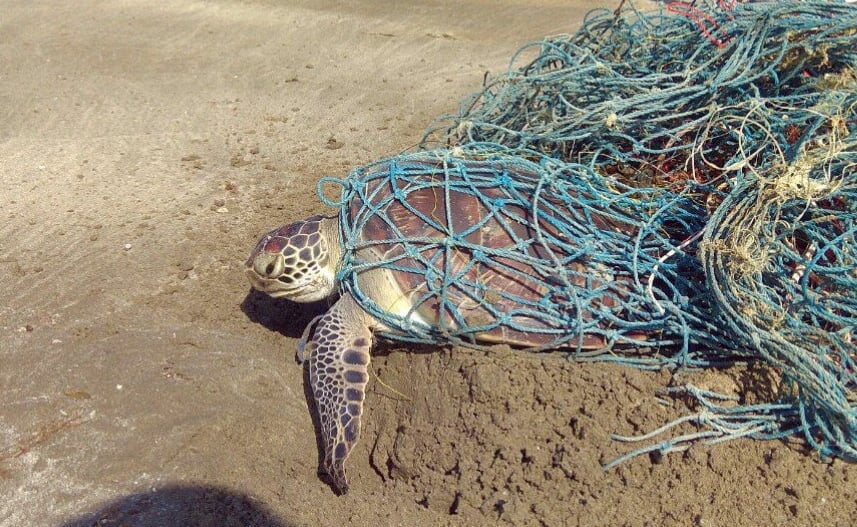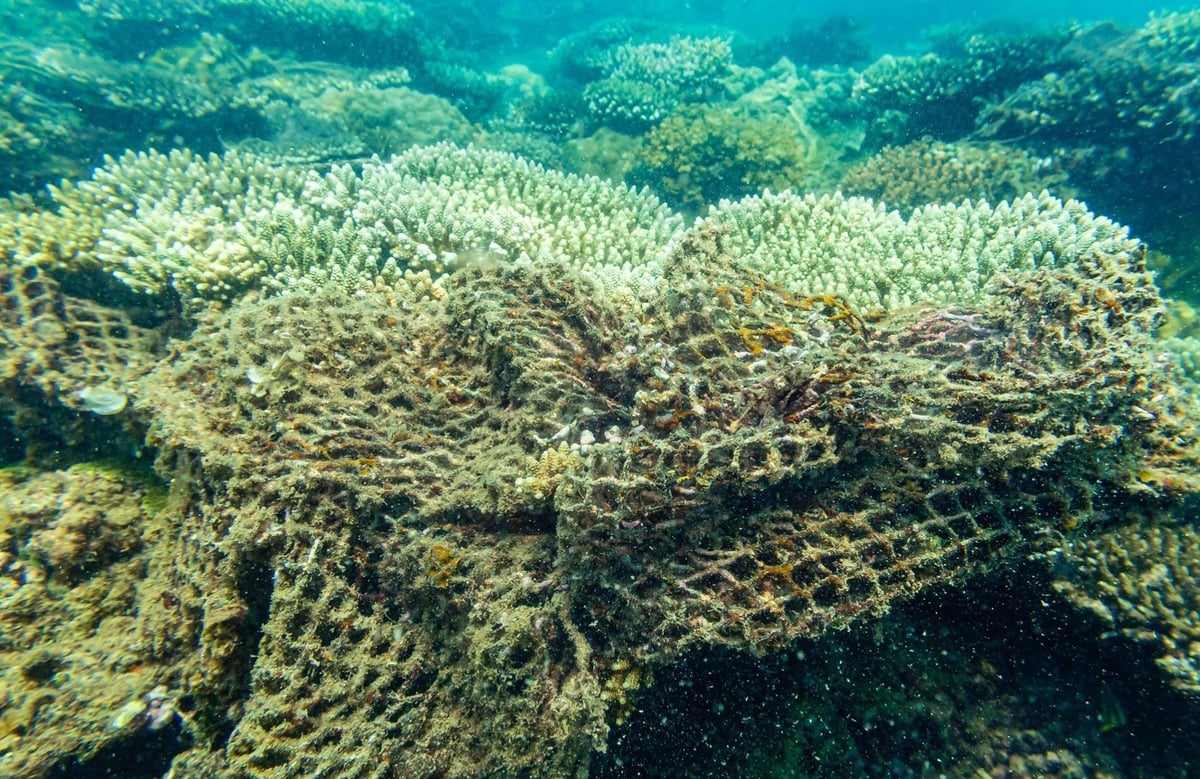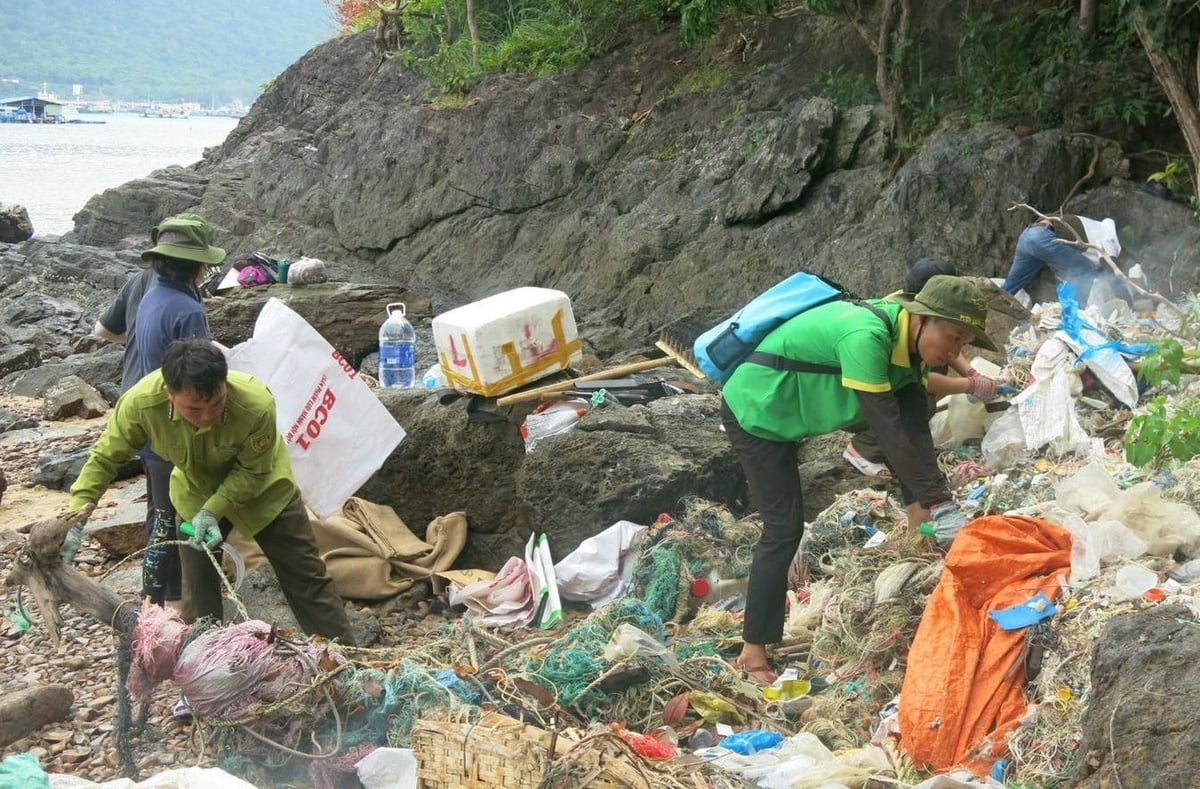November 10, 2025 | 17:38 GMT +7
November 10, 2025 | 17:38 GMT +7
Hotline: 0913.378.918
November 10, 2025 | 17:38 GMT +7
Hotline: 0913.378.918
Once regarded as one of Vietnam’s most pristine and diverse marine ecosystems, the waters around Con Dao boast around 1,400 hectares of coral reefs, 2,400 hectares of seagrass beds, and serve as a habitat for hundreds of marine species, including sea turtles and dugongs - one of Southeast Asia’s rarest marine mammals. However, these ecosystems are now facing severe degradation due to the impact of ocean waste.
According to the Con Dao National Park Management Board, from 2020 to 2024, the area of degrading coral reefs has been increasing, with one of the main causes being plastic waste, abandoned fishing nets, and hard debris entangled in the coral. Plastic waste clinging to the reefs prevents sunlight from reaching the coral, hindering their ability to photosynthesize. Prolonged exposure to such conditions leads to the gradual death of coral reefs and the subsequent loss of habitat for numerous fish species.

This sea turtle was promptly rescued from a ghost net by staff from the Con Dao National Park Management Board and released back into the ocean in 2023. Photo: Le Hong Son.
Ocean waste not only affects coral reefs but also poses a direct threat to marine creatures. Over the past three years, at least 14 sea turtles have either become entangled in fishing nets or died after ingesting plastic. One alarming case occurred in 2023, when a 70-kg turtle was found near Bai Nhat beach with a stomach full of plastic bags.
In many instances, tourists walking along the shore have discovered endangered sea turtles caught in fishing gear. Recently, while hiking through the forest trail to Dam Tre Bay, Dutch tourists Jos and Kim stumbled upon a pile of discarded fishing waste near the beach. As they approached, Jos noticed movement within the tangled netting and found a hawksbill turtle trapped inside.
The fishing net had tightly wrapped around the turtle’s body, with parts buried under sand, making it impossible for the animal to free itself. Without hesitation, Jos carefully untangled the net and released the hawksbill back into the sea. Kim documented the entire rescue operation and shared the photos and videos with Con Dao National Park authorities for monitoring.
Once ranked among Asia’s top 10 eco-tourism destinations by CNN (2019), Con Dao is renowned for coral diving, turtle nesting observations, mangrove exploration, and spiritual retreats. Yet, the sight of trash-littered beaches is tarnishing the reputation of this once pristine “hidden gem” of Vietnam’s tourism landscape.

Trash-filled waters, bleached corals, and fewer fish… these are some of the comments international visitors have made about Con Dao’s sea. Photo: Nguyen Van Vung.
Ms. Le Hong Tham, owner of a beachfront homestay, shared: “In the past, European tourists loved Con Dao. They were drawn to its pristine, clear-blue waters. But recently, some groups have complained about trash on the beaches, fewer fish while diving, and bleached coral.”
Not only that, scuba diving tours were once a highlight of Con Dao’s ecotouris, but they have seen a drop in bookings. Since 2024, warming sea temperatures due to climate change have also accelerated coral bleaching. Several tour operators have been forced to adjust their itineraries, opting for land-based activities or rerouting visitors to more remote areas to avoid floating trash.
Con Dao’s once-proud title as a world-class eco-destination is now under threat. At recent tourism conferences, experts repeatedly warned about the damaging impact of plastic pollution on both the island’s image and its long-term ecological value.
Beyond tourism, ocean waste is directly affecting the livelihoods of hundreds of coastal households who rely on nearshore fishing and seafood harvesting.
According to data from the district government, Con Dao currently has over 200 small fishing boats, most operating close to shore. However, in the past three years, catches from these boats have dropped by an average of 20–30%. The decline is partly due to depleted fish stocks, but also because nets are frequently clogged or damaged by marine debris.
Mr. Phong, a fisherman with 30 years of experience, said: “Some days, I haul up the nets three times, and all three times it’s just trash. The nets tear, and I spend the whole day fixing them. No fish, just lost time and money.” Now, instead of going out to sea, he helps diving teams collect underwater trash, earning around 200,000 VND per day - less income, and highly unstable.
Other fishers have had to change jobs or move inland. Meanwhile, younger generations are turning away from life at sea, saying, “The ocean can’t feed us anymore.”

Ocean waste has been regularly collected by the Con Dao Special District People's Committee, along with organizations and individuals, but so far, it appears that only the surface of the problem has been addressed. Photo: Le Binh.
In response to the worsening situation, the Con Dao special administrative district has introduced several initiatives, such as the “Plastic-Reduced Urban Area” model and the “5 No’s” campaign (no votive paper, no styrofoam, no plastic bags, no plastic bottles, no single-use plastic trays), alongside waste sorting at source and large-scale beach clean-up drives. However, according to conservation organizations, most efforts currently focus on coastal waste, while underwater waste - the most dangerous still lacks a sustainable response mechanism.
At present, waste collection is mostly carried out by volunteers and semi-professional divers. Con Dao has yet to establish a dedicated marine waste task force, nor does it have specialized vessels or technologies to track waste flows. Without proper investment, the recovery of its marine ecosystem remains uncertain.
WWF and other international organizations have proposed that the Con Dao authorities establish a specialized task force on marine debris, invest in equipment, provide workforce training, and coordinate waste management efforts from the shoreline to the seafloor. Simultaneously, there is a pressing need to establish cooperation mechanisms with neighboring provinces, the origin of much of the drifting trash to tackle waste at its source.
In the depths of the sea, where sunlight barely reaches, each plastic bag removed from a coral reef by divers is a glimmer of hope. “Con Dao’s sea is still beautiful. The coral is still alive. But it’s breathing weakly. If we don’t act now, it’ll be too late,” said diver Tùng, eyes fixed on the distant coral reef of Hon Tre Lon.
The journey to protect Con Dao’s ocean is far from over. But without professional, synchronized, and urgent action, this marine area was a symbol of untouched nature, may lose what defines it most: life itself.
Translated by Kieu Chi

(VAN) Numerous practical ideas, solutions, and proposals were presented at the national forum themed: ‘Rural Tourism Connected with Ecological Civilization and the Creation of a Green Living Environment.’

(VAN) TH Group is implementing multiple solutions to reduce white pollution, notably through the 'Collect Cartons - Spread Green Living' campaign and plastic reduction initiatives.

(VAN) Assoc. Prof. Dr. Nguyen Ngoc Son, a full-time National Assembly deputy serving on the Committee for Science, Technology and Environment, emphasized that agriculture and environment play a strategic role in the green era.

(VAN) Integrated management is the “key” to turning the immense potential of the sea into a driving force for national development, ensuring security, defense, and green, sustainable growth.

(VAN) Viet Nam’s hydrometeorological sector is undergoing strong innovation, aiming for modern, sustainable development and proactive disaster management.

(VAN) Viet Nam is accelerating its conservation efforts for nature and biodiversity, striving for green development, effective management, and community engagement to ensure the sustainable preservation of vital resources.

(VAN) The strengthened cooperation between two organizations, after 30 years of presence in Viet Nam, reflects a long-term commitment to a future where people and nature live in harmony.